chapter7翻译教程PPT课件
- 格式:pptx
- 大小:88.05 KB
- 文档页数:4
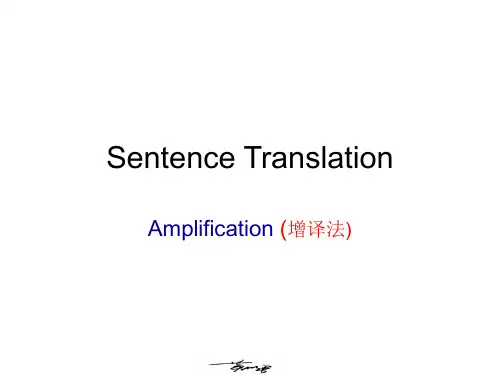
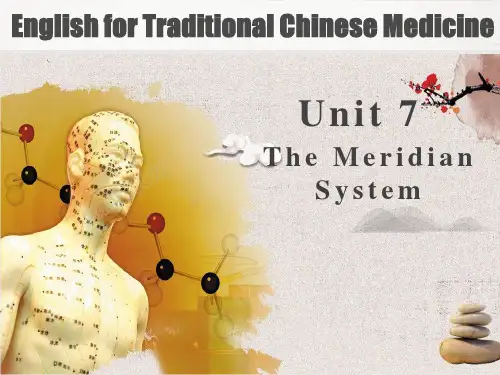
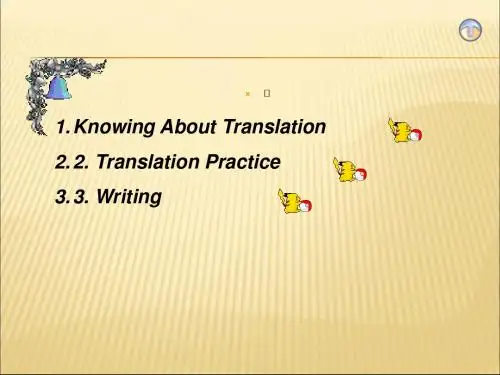
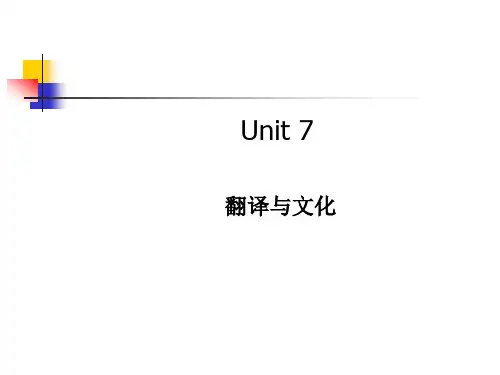
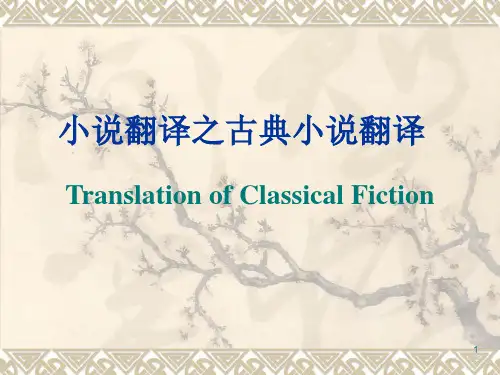
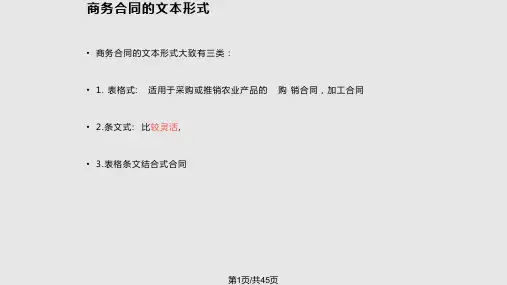
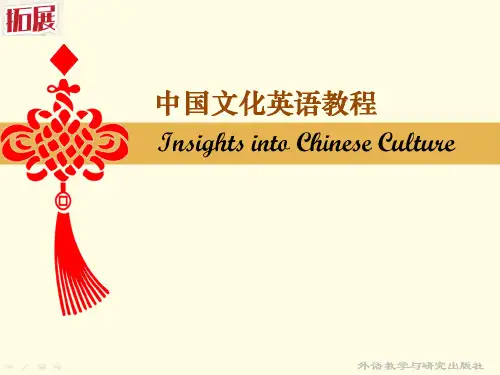
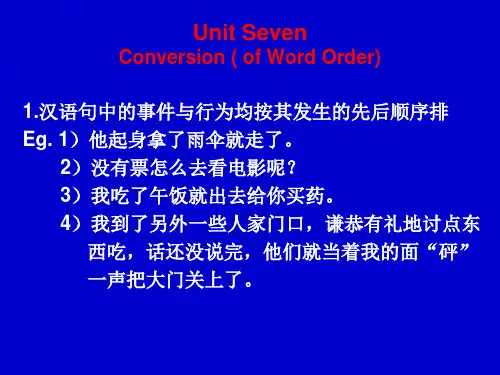
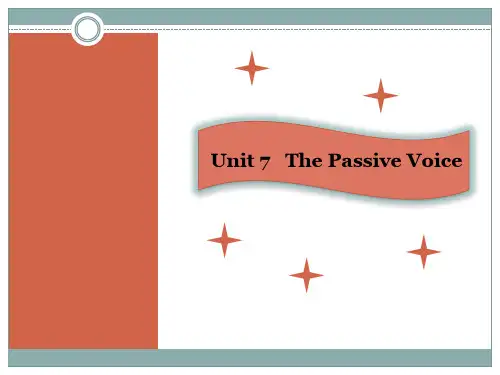
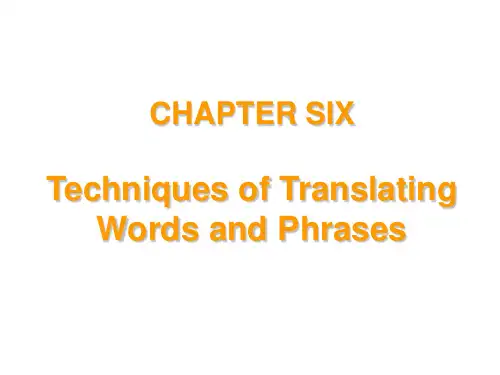
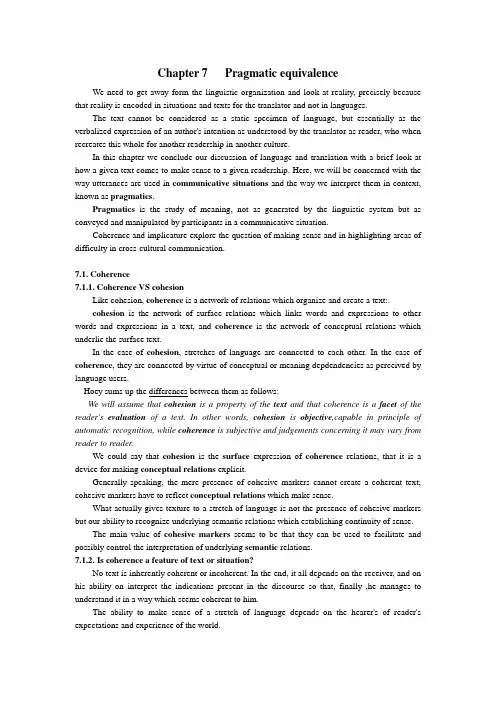
Chapter 7 Pragmatic equivalenceWe need to get away form the linguistic organization and look at reality, precisely because that reality is encoded in situations and texts for the translator and not in languages.The text cannot be considered as a static specimen of language, but essentially as the verbalized expression of an author's intention as understood by the translator as reader, who when recreates this whole for another readership in another culture.In this chapter we conclude our discussion of language and translation with a brief look at how a given text comes to make sense to a given readership. Here, we will be concerned with the way utterances are used in communicative situations and the way we interpret them in context, known as pragmatics.Pragmatics is the study of meaning, not as generated by the linguistic system but as conveyed and manipulated by participants in a communicative situation.Coherence and implicature explore the question of making sense and in highlighting areas of difficulty in cross-cultural communication.7.1. Coherence7.1.1. Coherence VS cohesionLike cohesion, coherence is a network of relations which organize and create a text:.cohesion is the network of surface relations which links words and expressions to other words and expressions in a text, and coherence is the network of conceptual relations which underlie the surface text.In the case of cohesion, stretches of language are connected to each other. In the case of coherence, they are connected by virtue of conceptual or meaning depdendencies as perceived by language users.Hoey sums up the differences between them as follows:We will assume that cohesion is a property of the text and that coherence is a facet of the reader's evaluation of a text. In other words,cohesion is objective,capable in principle of automatic recognition, while coherence is subjective and judgements concerning it may vary from reader to reader.We could say that cohesion is the surface expression of coherence relations, that it is a device for making conceptual relations explicit.Generally speaking, the mere presence of cohesive markers cannot create a coherent text; cohesive markers have to reflect conceptual relations which make sense.What actually gives texture to a stretch of language is not the presence of cohesive markers but our ability to recognize underlying semantic relations which establishing continuity of sense.The main value of cohesive markers seems to be that they can be used to facilitate and possibly control the interpretation of underlying semantic relations.7.1.2. Is coherence a feature of text or situation?No text is inherently coherent or incoherent. In the end, it all depends on the receiver, and on his ability on interpret the indications present in the discourse so that, finally ,he manages to understand it in a way which seems coherent to him.The ability to make sense of a stretch of language depends on the hearer's of reader's expectations and experience of the world.The coherence of a text is a result of the interaction between knowledge presented in the text and the reader's own knowledge and experience of the world.Even a simple cohesive relation of co-reference cannot be recognized, and therefore cannot be said to contribute to the coherence of a text.Blum-Kulka's definition of coherence as a covert potential meaning relationship among parts of a text, made overt by the reader or listener through processes of interpretation implies that she sees meaning , or coherence as a property of a ext, even though it is only accessible through processes of interpretation.Sinclair(personal communication) similarly states that processes such as the recall of past experience and knowledge of the world...are not part of the meaning of a text, but part of the human apparatus for working out the meaning of a text, which again suggests that meaning exists in texts but can only be accessed through various processes of interpretation on the part of the reader.Firth asserts that meaning is a property of the mutually relevant people, things, events in the situation.Kirsten Malmkjaer(personal communication) does not accept the view that meaning is in text and suggests instead that meaning arise in situation involving language.A reader's cultural and intellectual background determine how much sense she or he gets out of a text.Regardless of whether meaning is a property of text or situation, coherence is not a feature of text as such but of the judgement made by a reader on a text.A translator has to take account of the range of knowledge available to his or her target readers and of the expectations they are likely to have about.We can only make sense of new information in terms of our own knowledge, beliefs, and previous experience of both linguistic and non-linguistic events.7.2. Coherence and processes of interpretation: implicatureThe difference between supplemental interpretations and explanatory interpretations is that the former never lead to the explication of a thematic continuity, whereas the latter justify this continuity.One of the most important notions which have emerged in text studies in recent years is that of implicature, which refers to what the speaker means or implies rather than what she or he literally says.Grice suggests that a speaker can signal an implied meaning conventionally and non-conventionally. To signal an implied meaning conventionally, a speaker uses the textual resources which are conventionally understood to signal certain relationships between propositions. Grammatical structure is another.Grice suggests that discourse has certain important features:for instance, it is connected; it has a purpose; and it is a co-operative effort. These features give rise to a general principle of communication, the Co-operative Principle(CP).Implied meaning which is not signalled conventionally derives from the Co-operative Principle and a number of maxims associated with it: quantity, quality, relevance and manner.Grice's maxims provide a point of orientation for participants even when they are flouted, so that flouting them is recognized as a way os exploiting the convention in order to convey anintended meaning.Apart from observing the maxims, a language user can deliberately flout a maxim and in doing so produce what Grice called a conversational implicature.例证:do you know what time it is?分析:it may means"I don's know the time""I wish to know the time. Levinson calls this type of meaning a standard implicature. It could convey a meaning such as "you are very late", this is what Grice would call a conversational implicature.Conversational implicature can be conveyed by flouting any or several of the maxims.7.3. Coherence, implicature, and translation strategies7.3.1. The conventional meanings of words and structures and the identity of references7.3.1.1. The conventional meanings of words and structuresAs well as the conventional meaning of words, each language also employs conventionalized expressions and patterns of conveying implicatures. In other words, in every language there will be conventional associations between certain linguistic patterns and certain inferable meanings.Typographic features also play a role in conveying certain implicatures.7.3.1.2. The identity of any references that may be involvedThe English translator attempts to bridge the gap between the textual world and the world of the target reader by explaining the unfamiliar in terms of the familiar.Identifying reference is not just a question of identifying roughly who or what the referent is but, crucially, of knowing enough about the referent to interpret the particular associations it is meant to trigger in our minds in a given context.It is the ability to interpret the significance of a given reference and the way it links with other features of the context and co-text that contributes to the continuity of sense or coherence of a text and enables us to draw any intended implicatures.The ability to identify a referent may also be influenced by one's perspective.7.3.2. The Co-operative Principle and its maximsGrice suggests that the CP and its maxims are not arbitrary but are a feature of any rational behaviour, be it linguistic or non-linguistic.CP and its maxims are universal, on the assumption that linguistic behaviour is just one type of rational behaviour and that all human beings are rational.A certain type of implicature, say quality implicature, is never used by the speakers of a particular language, or that the contexts in which a type of implicature will be used will differ from one language community to the next.Even within the same cultural and linguistic community, there are sometimes special contexts in which one or more of the maxims do not apply.The four maxims do not represent an exhaustive list and suggested that other maxims such as "be polite" may be added. It would suggest that the maxim of quality and manner are easily overrien by considerations of politeness in some cultures.Hatim and Mason's comment on quantity that what is required for any given communicative purpose within a TL cultural environment is...a matter for the translator's judgement.An important factor which seems to override Grice's maxims and support the possibility that they are both language- and culture-specific relates to norms of discourse organization and rhetorical functions in different languages.Weakness of definition aside, it is interesting that Grice's maxims seem to reflect directly notions which are known to be valued in the English-speaking world, for instance sincerity, brevity, and relevance. These do not necessarily have the same value in other cultures, nor should they be expected to represent any ideal basis for communication.A more plausible suggestion would be that all discourse, in any language, is essentially co-operative and that the phenomenon of implicature(rather than the specific maxims suggested by Grice) is universal. In other words, the interpretation of a maxim or the maxims themselves may differ from one linguistic community to anther, but the process of conveying intended meaning by means of exploiting whatever maxims are in operation in that community will be the same.7.3.3. The context, linguistic or otherwise, of the utteranceThe context in which an utterance occurs determines the range of implicatures that may sensibly be derived from it.Sperber and Wilson suggest that the context does much more than filter out inappropriate interpretations; it provides premises without which the implicature cannot be inferred at all.The inability to relate a piece of information to his or her own context can lead the reader to draw the wrong inferences from a text.When a person describe something, recounts an event, or lists a number of items, she or he will normally follow a preferred sequence rather than a random one.Levinson relates the question of normal ordering of events in the real world to the sub-maxim of manner, “be orderly”. He suggests that it is because we expect participants in a discourse to respect the maxim"Be orderly" that we expect them to recount events in the order in which they happened.T emporal order may be a widespread or universal ordering strategy, but there are other types of preferences for ordering strategies which tend to be language- and culture-specific.The "sense of apropriateness" could provide the context for interpreting the additional maxim 'Be polite' posited earlier.7.3.4.. Other items of background knowledgeThere is a great deal of overlap between identifying reference and accessing relevant background information.The study of implicature may provide a practical solution to the well known problem of deciding what parts of the original shared context should be built into the text of the translation and what should be provided separately, for example in footnotes. Information essential to the success of conversational implicatures should be included in the text if the translation is to be coherent and sensible. It is unrealistic and working against the pragmatic nature of language to put such information into footnotes.As well as expanding a text to provide the necessary background information, a translator may decide to delete information that the target readership can be assumed to be familiar with .In any act of communication, a text does not necessarily have to conform to the expectations of its readership. Readers' versions of reality, their expectations, and their preferences can be challenged without affecting the coherence of a text, provided the challenge is motivated and the reader is prepared for it.7.3.5. The availability of all relevant items falling under the previous headingsIn order to convey an intended meaning, the speaker or writer must be able to assume that the hearer or reader has access to all the necessary background information, features of the context...The less the writer assumes that the reader has access to the more she or he will provide in the way of explanation and detail.In translation, anything that is likely to violate the target reader's expectations must be carefully examined and, if necessary, adjusted in order to avoid conveying the wrong implicatures or even failing to make sense altogether.Unless motivated, a deviant configuration at any linguistic level may block a participant's access to the conventional meaning of the words and structures used and can directly affect the coherence of a text.Any disturbance to the normal organizational patterns of language must therefore be motivated, otherwise the reader will not be able to make sense of it.Most professional translators appreciate the need to fulfil a reader's expectations about the organization of the target language in order to maintain the coherence of a text and avoid giving rise to unwanted implicatures.Reader's expectation do not necessarily have to be fulfilled.We are normally prepared to accept a great deal of unusual and even bizarre linguistic behaviour provided it can be justified, for instance on the basis of poetic creativity or humour.The suggestion that deviations form normal patterning have to be motivated implies that they have to occur in a context that is interpretable by the hearer or reader.Blackmore suggests that a speaker or writer who wants his or her utterance to be interpreted in a certain way must expect it to be interpreted in a context that yields that interpretation.in order to maintain coherence translators often have to minimize discrepancies between the model of the world presented in the source text and that with which the target reader is likely to be familiar. The extent of intervention varies considerably and depends in the final analysis on 2 main factor:①The first is the translator 's ability to access the knowledge and expectations of the target reader--the more the target reader is assumed to know, the less likely that the translator will be inclined to intervene with lengthy explanations likewise, the more harmony is assumed to exist between the model of the world presented in the source text and the target culture's version os the world, the more inclined the translator will be to remain invisible, i.e.refrain from direct intervention.②The second factor is the translator's own view of his or her role and of the whole question of where his or her loyalties ought to lie--whether they ought to lie with the source text or with the target reader.The main difficulties seem to be concerned with the ability to assess the target reader's range of knowledge and assumptions about various aspects of the world, and to strike a reasonable balance between, on the one hand, fulfilling their expectations and, on the other hand, maintaining their interest in the communication by offering them new or alternative insights.Brown and Y ule suggest that the principle of analogy and local basis of the assumption of coherence in our experience of life in general, hence in our experience of discourse as well.In attempting to fill gaps in their reader's knowledge and fulfil their expectations of what is normal or acceptable, translator should be careful not to 'overdo' things by explaining too much and leaving the reader with nothing to do.。